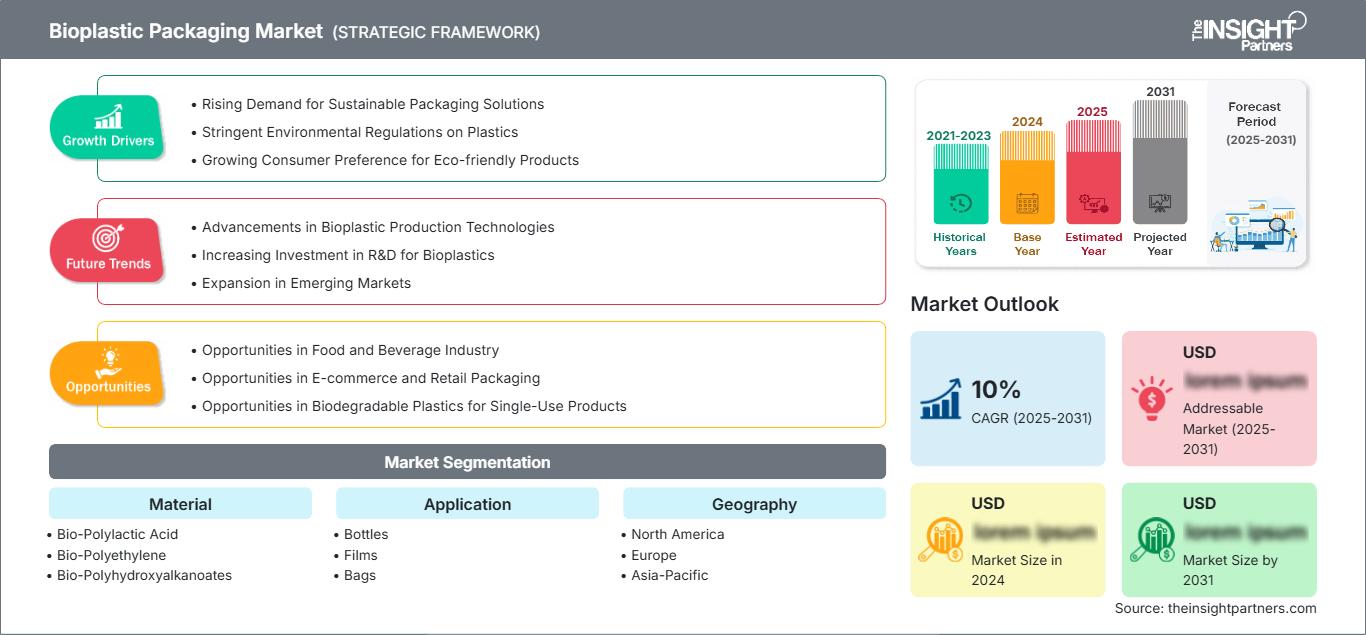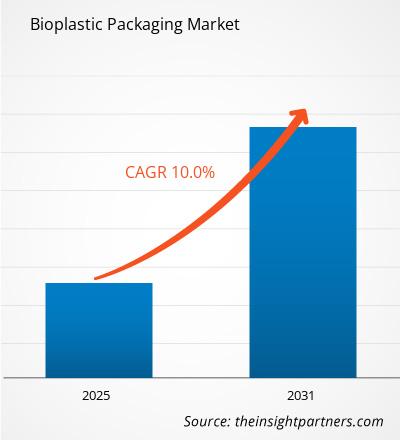Le marché des emballages bioplastiques devrait atteindre 54,24 milliards de dollars américains d'ici 2031. Il devrait enregistrer un TCAC de 15,7 % entre 2025 et 2031.
Ce rapport présente une analyse basée sur les matériaux (acide polylactique biosourcé, polyéthylène biosourcé, polyhydroxyalcanoates biosourcés, téréphtalate de polyéthylène biosourcé et autres). Il est segmenté par application (bouteilles, films, sacs, sachets, gobelets et barquettes, et autres) et par utilisation finale (alimentation et boissons, cosmétiques et soins personnels, produits pharmaceutiques et nutraceutiques, biens de consommation et autres). L'analyse mondiale est ensuite ventilée par région et par principaux pays. La taille du marché et les prévisions aux niveaux mondial, régional et national pour tous les segments clés sont couvertes par le rapport. Les valeurs sont exprimées en dollars américains. Le rapport fournit des statistiques clés sur la position des principaux acteurs du marché et présente les tendances et opportunités du marché.
Objectif du rapport
Le rapport sur le marché des emballages bioplastiques, réalisé par The Insight Partners, vise à décrire le paysage actuel et la croissance future, les principaux facteurs de croissance, les défis et les opportunités. Il fournira des informations précieuses à diverses parties prenantes, telles que :
- Fournisseurs de technologies/Fabricants : Pour comprendre l’évolution de la dynamique du marché et identifier les opportunités de croissance potentielles, afin de prendre des décisions stratégiques éclairées.
- Investisseurs : Pour réaliser une analyse approfondie des tendances concernant le taux de croissance du marché, les projections financières et les opportunités tout au long de la chaîne de valeur.
- Organismes de réglementation : Pour encadrer les politiques et les activités du marché afin de minimiser les abus, préserver la confiance des investisseurs et garantir l’intégrité et la stabilité du marché.
Segmentation du marché des emballages bioplastiques
- Acide polylactique bio
- Polyéthylène bio
- Polyhydroxyalcanoates bio
- Téréphtalate de polyéthylène bio
Application
- Bouteilles
- Films
- Sacs
- Sachets et sachets
- Gobelets et plateaux
Vous bénéficierez d’une personnalisation sur n’importe quel rapport - gratuitement - y compris des parties de ce rapport, ou une analyse au niveau du pays, un pack de données Excel, ainsi que de profiter d’offres exceptionnelles et de réductions pour les start-ups et les universités
Marché des emballages en bioplastique: Perspectives stratégiques

-
Obtenez les principales tendances clés du marché de ce rapport.Cet échantillon GRATUIT comprendra une analyse de données, allant des tendances du marché aux estimations et prévisions.
Facteurs de croissance du marché des emballages bioplastiques
- Demande croissante de solutions d'emballage durables : La demande croissante des consommateurs pour des emballages écologiques et durables est un moteur essentiel du marché des emballages bioplastiques. Face à l'augmentation des déchets plastiques et des préoccupations environnementales, les bioplastiques, fabriqués à partir de ressources renouvelables telles que les matières végétales, offrent une alternative biodégradable aux plastiques conventionnels. Cette demande de solutions d'emballage durables incite les industries agroalimentaires, de la distribution et des biens de consommation à adopter les emballages bioplastiques, stimulant ainsi la croissance du marché.
- Réglementations environnementales strictes sur les plastiques : Les gouvernements du monde entier mettent en œuvre des réglementations plus strictes sur les déchets plastiques, la pollution et les emballages non biodégradables, ce qui stimule la demande de bioplastiques. Des politiques telles que l'interdiction du plastique et les programmes de responsabilité élargie des producteurs (REP) encouragent les fabricants à se tourner vers des alternatives biodégradables et compostables. Les bioplastiques offrent une solution viable pour répondre aux exigences réglementaires, favorisant ainsi la croissance du marché des emballages bioplastiques, les industries cherchant à se conformer aux normes environnementales.
- Préférence croissante des consommateurs pour les produits écologiques : Les consommateurs privilégient de plus en plus les produits ayant un impact environnemental minimal. Sensibilisés à l’empreinte écologique des emballages, ils recherchent activement des produits aux emballages durables. Cette demande croissante de produits éco-responsables incite les marques à opter pour les emballages bioplastiques dans le cadre de leurs initiatives de développement durable, contribuant ainsi à la croissance globale du marché.
Tendances futures du marché des emballages bioplastiques
- Progrès des technologies de production de bioplastiques : Les avancées technologiques dans la production de bioplastiques améliorent la faisabilité et les performances des emballages bioplastiques. Les innovations dans les technologies de transformation améliorent l’efficacité et la rentabilité des bioplastiques, les rendant plus compétitifs par rapport aux plastiques traditionnels. Le développement de nouveaux polymères biosourcés, tels que l’acide polylactique (PLA) et les polyhydroxyalcanoates (PHA), offrant une durabilité et une fonctionnalité accrues, stimule la croissance et l’adoption des emballages bioplastiques dans divers secteurs. Investissements croissants en R&D pour les bioplastiques : Les investissements en recherche et développement (R&D) créent de nouvelles opportunités pour le marché des emballages bioplastiques. Les fabricants s’attachent à développer des bioplastiques aux propriétés améliorées, telles qu’une résistance, une flexibilité et une résistance à l’humidité et à la chaleur accrues. De plus, les efforts de R&D visent l’utilisation de matières premières plus durables et d’origine locale pour les bioplastiques. Ces innovations contribuent à accroître la polyvalence du marché et à étendre ses applications dans le domaine de l’emballage. Expansion sur les marchés émergents : Les économies émergentes de régions comme l’Asie-Pacifique, l’Amérique latine et l’Afrique connaissent une croissance rapide de l’adoption des emballages bioplastiques. La prise de conscience croissante de la pollution plastique, conjuguée aux pressions réglementaires et aux incitations gouvernementales en faveur d’emballages durables, encourage les entreprises de ces régions à se tourner vers les bioplastiques. La demande croissante de solutions d'emballage écologiques dans les régions en développement crée d'importantes opportunités de croissance pour les fabricants d'emballages bioplastiques.
Opportunités du marché des emballages bioplastiques
- Opportunités dans l'industrie agroalimentaire : L'industrie agroalimentaire présente d'importantes opportunités pour le marché des emballages bioplastiques en raison de sa forte demande en solutions d'emballage. Les bioplastiques offrent une option durable pour l'emballage des produits alimentaires, avec des avantages tels que la biodégradabilité et la compostabilité. Alors que les préférences des consommateurs évoluent vers des options d'emballage plus durables, les bioplastiques deviennent de plus en plus populaires dans l'emballage alimentaire, créant des opportunités de croissance pour les fabricants ciblant ce secteur.
- Opportunités dans le commerce électronique et l'emballage de détail : Avec l'essor du commerce électronique, la demande de solutions d'emballage durables augmente dans la vente au détail en ligne. Les bioplastiques émergent comme une option viable pour l'emballage du commerce électronique en raison de leurs caractéristiques écologiques. L'attention accrue portée à la réduction des déchets plastiques dans les processus d'expédition et d'emballage encourage les détaillants à adopter des alternatives bioplastiques, créant une opportunité lucrative pour le marché de se développer dans le secteur du commerce électronique.
- Opportunités offertes par les plastiques biodégradables pour les produits à usage unique : Le marché des alternatives aux plastiques à usage unique présente d’importantes opportunités pour les bioplastiques. Les couverts, les pailles et les emballages, par exemple, figurent parmi les plastiques à usage unique les plus courants et contribuent à la pollution plastique. Face à la demande croissante des gouvernements et des consommateurs, les bioplastiques offrent une solution biodégradable pour ces produits. Cette transition vers des emballages et des produits durables stimule la croissance des bioplastiques sur le marché des plastiques à usage unique.
Marché des emballages bioplastiques
Les analystes de The Insight Partners ont analysé en détail les tendances régionales et les facteurs influençant le marché des emballages bioplastiques tout au long de la période prévisionnelle. Cette section aborde également les segments et la répartition géographique du marché de la gestion des troubles du rythme cardiaque en Amérique du Nord, en Europe, en Asie-Pacifique, au Moyen-Orient et en Afrique, ainsi qu'en Amérique du Sud et centrale.
Portée du rapport sur le marché des emballages bioplastiques
| Attribut de rapport | Détails |
|---|---|
| Taille du marché en 2024 | US$ XX Billion |
| Taille du marché par 2031 | US$ 54.24 Billion |
| TCAC mondial (2025 - 2031) | 15.7% |
| Données historiques | 2021-2023 |
| Période de prévision | 2025-2031 |
| Segments couverts |
By Matériau
|
| Régions et pays couverts |
Amérique du Nord
|
| Leaders du marché et profils d'entreprises clés |
|
Densité des acteurs du marché de l'emballage bioplastique : comprendre son impact sur la dynamique commerciale
Le marché des emballages bioplastiques connaît une croissance rapide, portée par une demande croissante des utilisateurs finaux, elle-même alimentée par l'évolution des préférences des consommateurs, les progrès technologiques et une meilleure connaissance des avantages du produit. Face à cette demande grandissante, les entreprises élargissent leur offre, innovent pour répondre aux besoins des consommateurs et tirent parti des tendances émergentes, ce qui stimule davantage la croissance du marché.

- Obtenez le Marché des emballages en bioplastique Aperçu des principaux acteurs clés
Points clés de vente
- Couverture exhaustive : Ce rapport analyse en détail les produits, services, types et utilisateurs finaux du marché des emballages bioplastiques, offrant ainsi une vision globale.
- Analyse d'experts : Ce rapport repose sur une connaissance approfondie du secteur et des analystes.
- Informations actualisées : Grâce à sa couverture des informations et tendances les plus récentes, ce rapport garantit la pertinence des données pour les entreprises.
- Options de personnalisation : Ce rapport peut être personnalisé pour répondre aux besoins spécifiques des clients et s'adapter parfaitement à leurs stratégies commerciales.
Ce rapport d'étude de marché sur les emballages bioplastiques peut donc contribuer à décrypter et comprendre le contexte sectoriel et les perspectives de croissance. Malgré quelques points à améliorer, les avantages globaux de ce rapport l'emportent sur les inconvénients.
- Analyse historique (2 ans), année de base, prévision (7 ans) avec TCAC
- Analyse PEST et SWOT
- Taille du marché Valeur / Volume - Mondial, Régional, Pays
- Industrie et paysage concurrentiel
- Ensemble de données Excel
Rapports récents
Rapports connexes
Témoignages
Raison d'acheter
- Prise de décision éclairée
- Compréhension de la dynamique du marché
- Analyse concurrentielle
- Connaissances clients
- Prévisions de marché
- Atténuation des risques
- Planification stratégique
- Justification des investissements
- Identification des marchés émergents
- Amélioration des stratégies marketing
- Amélioration de l'efficacité opérationnelle
- Alignement sur les tendances réglementaires






















 Obtenez un échantillon gratuit pour - Marché des emballages en bioplastique
Obtenez un échantillon gratuit pour - Marché des emballages en bioplastique